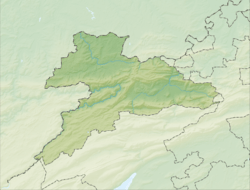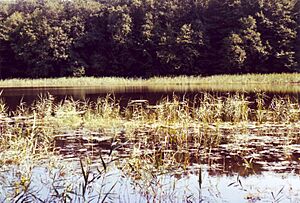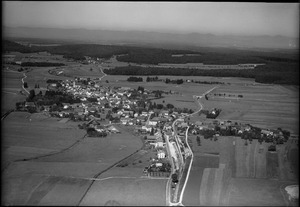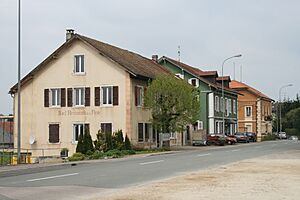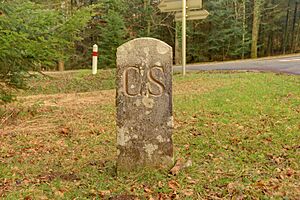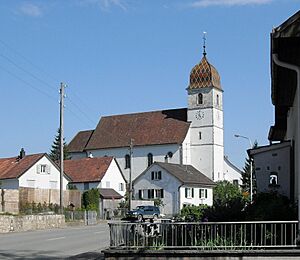Bonfol facts for kids
Quick facts for kids
Bonfol
|
||
|---|---|---|
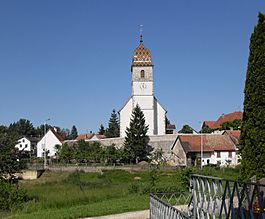
The church of Saint-Laurent at Bonfol
|
||
|
||
| Country | Switzerland | |
| Canton | Jura | |
| District | Porrentruy | |
| Area | ||
| • Total | 13.59 km2 (5.25 sq mi) | |
| Elevation | 432 m (1,417 ft) | |
| Population
(2004)
|
||
| • Total | 668 | |
| • Density | 49.15/km2 (127.31/sq mi) | |
| Demonym(s) | les Bâts (les Crapauds) | |
| Postal code |
2944
|
|
| Localities | - | |
| Surrounded by | Beurnevésin, Damphreux, Vendlincourt, Courtavon(F), Pfetterhouse(F) | |
Bonfol is a small town that used to be a separate municipality in Switzerland. It is located in the Jura canton, in the Porrentruy area. Bonfol was also known for having one of Switzerland's most challenging waste sites.
Contents
History of Bonfol
Bonfol was first mentioned in old records in 1136. Back then, it was called Bunfol. It also had a German name, Pumpfel, but this name is no longer used today.
Local stories say the village was started after the Burgundian Wars. A person named Stephan of Hagenbach, who worked for Charles the Bold, needed a new place. His old villages, Bonfol-le-Vieux, Trunchéré, and Vareroille, had been destroyed.
During World War I (1914-1918), the Western Front was a battle line. This important line between the Allies and Germany started in Bonfol. Specifically, it began in a part of the village called Le Largin.
On January 1, 2024, Bonfol is planned to join with another town, Beurnevésin. Together, they will form a new municipality called Basse-Vendline.
Geography of Bonfol
Bonfol covers an area of about 13.59 square kilometers (5.25 square miles). A large part of this land, about 47.2%, is used for farming. Forests cover another big portion, about 43.9% of the area.
Buildings and roads take up about 6.9% of the land. Rivers and lakes make up 1.5%. A very small part, 0.5%, is unproductive land. Most of the water in Bonfol is found in its lakes.
The town is located in the Porrentruy district. It is in the northeast corner of the Ajoie region. Bonfol also sits right on the border with France.
A special nature area called Etangs de Bonfol (Bonfol Ponds) is near the village. It is a protected place for nature and wildlife.
The Bonfol Waste Dump Cleanup
Starting in 1961, some big medicine and chemical companies from Basel began burying chemical waste. They used an old clay mine outside Bonfol for this purpose. Eight of the largest companies, including BASF, Novartis, Roche, and Syngenta, worked together. They formed a group called Basler Chemischen Industrie (BCI) to manage the site.
The Bonfol dump was used until 1976. Over 15 years, about 114,000 tons of chemicals were buried there. After it closed, BCI thought the clay would keep the waste safely in place. The dump was covered, and the land, which was about 20,000 square meters, was replanted.
However, in 1981, leaks were found coming from the dump. From 1986 to 1995, BCI installed a system to drain the water. They also built a plant to treat the polluted water. After protests from groups like Greenpeace, a new Swiss law was passed in 1998. This law was about cleaning up contaminated sites.
On October 17, 2000, BCI agreed with the Canton to fully dig up and clean the entire dump. In 2007, construction began on a huge building called an excavation hall. This hall covered the whole waste site. Inside, a large crane and digging bucket were used to remove up to 160 tons of polluted soil each day.
The contaminated soil was then put into special sealed train cars. These cars took the soil to incinerators in Germany. There, it was burned at very high temperatures, up to 1200 degrees Celsius (2192 degrees Fahrenheit). This process turned the harmful waste into safe ash.
In July 2010, some chemicals in the dump exploded during the digging. One worker had minor injuries. The project stopped for several months to check for dangers. By the end of August 2016, all the contaminated soil was removed. In total, 202,200 tons were taken out and burned. The entire cleanup project cost BCI about 380 million Swiss francs.
Bonfol's Coat of Arms
The official design of Bonfol's coat of arms is simple. It shows a silver shield with a blue stripe going across it. In the top left corner, there is a blue five-pointed star.
People of Bonfol (Demographics)
Bonfol has a population of about 668 people. As of 2008, about 7% of the people living there were foreign nationals. Over the last ten years (2000-2010), the population decreased by about 6%.
Most people in Bonfol speak French as their main language. About 84.7% speak French. The second most common language is German, spoken by about 12.2% of the people. A smaller number, about 1.6%, speak Spanish.
In 2008, about 47.5% of the population was male, and 52.5% was female. Many people were born in Bonfol or in the same canton. About 15.5% of the population was born outside Switzerland.
Children and teenagers (ages 0-19) make up about 19.6% of the population. Adults (ages 20-64) are the largest group, at 55.5%. Seniors (over 64 years old) make up about 24.9%.
In 2000, there were 303 households in Bonfol. On average, each household had 2.2 people. About one-third of households had only one person.
The number of people living in Bonfol has changed over time, as shown in this chart:

Bonfol's Economy
In 2010, Bonfol had an unemployment rate of 6.1%. This means about 6.1% of people looking for jobs could not find one.
In 2008, there were 41 people working in the primary economic sector. This sector includes jobs like farming and forestry. There were 17 businesses in this area.
The secondary sector employed 145 people. This sector includes jobs like manufacturing and construction. There were 11 businesses in this area.
The tertiary sector had 73 people working. This sector includes jobs in services, like shops, restaurants, and healthcare. There were 18 businesses in this area.
Many people who live in Bonfol travel to other towns for work. In 2000, 150 workers left Bonfol for jobs elsewhere. About 134 workers came into Bonfol for work. Most people used a private car to get to work.
Religion in Bonfol
Based on a 2000 survey, most people in Bonfol are Roman Catholic, about 65.8%. Another 19.6% belong to the Swiss Reformed Church.
A smaller number of people belong to other Christian churches. There are also a few people who follow Islam, Buddhism, or Hinduism. About 4.57% of the population do not belong to any church.
Education in Bonfol
In Bonfol, about 26.5% of the people have finished upper secondary education. This is education after the main school years. About 5.3% have gone on to higher education, like university.
The Canton of Jura has a specific school system. It starts with two years of optional Kindergarten. Then, students go to six years of Primary school. After that, there are three years of required lower Secondary school. In secondary school, students are grouped by their skills.
After lower Secondary, students can choose to go to an optional upper Secondary school for three or four years. They can also start an apprenticeship to learn a trade.
During the 2009-2010 school year, 34 students attended 3 classes in Bonfol. There were no kindergarten classes in the town. Bonfol had 2.5 primary classes with 34 students. Since there are only nine Secondary schools in the canton, students from Bonfol go to secondary school in other towns.
Transportation in Bonfol
Bonfol is at the northern end of the Porrentruy–Bonfol railway line. It has a train station called Bonfol railway station, with regular train services.
See also
 In Spanish: Bonfol para niños
In Spanish: Bonfol para niños




